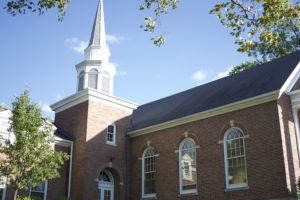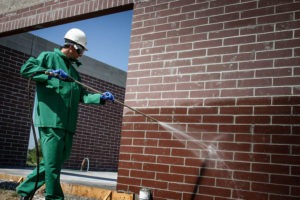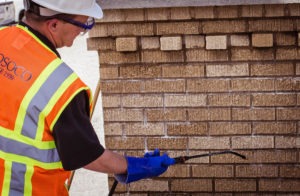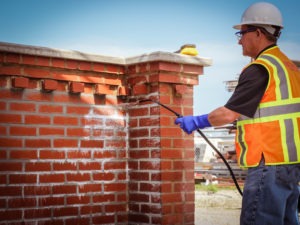Material Cleaning
Words: Joanne AndersonLaundering Buildings: Part I, Cleaning New Construction
Words: Joanne M. Anderson
Photos: PROSOCO and Masonry Magazine
You may not be able to fold a building and toss it into a washing machine, but the motivation for cleaning has striking similarities to the two top reasons for removing dirt, grime and grease from your clothes:
Despite our best efforts, we do judge a book by its cover, people by their attire and a building by its outward appearance. On the residential front, this is what keeps painters, shutter and garage door manufacturers and landscapers in business. Like it or not, first impressions set the stage for everything that follows, commercial buildings notwithstanding. Curb appeal can be a deal breaker for a sale - whether you are trying to sell a whole new building, promote products or services from a company inside, lease condos in a high-rise or sell tickets for a performance. It's human nature to draw conclusions from surface views.
Once clothes are clean, it's easier to check for damage. Okay, some people buy pre-torn jeans, but there are just as many - or more - who check their jeans for rips and stains or shirts for wear and tear as a measure for when to repair or replace them. On a dirty building, even a brand new one, you might not see unexpected irregularities or the desired final finish.
Back to the home laundry analogy, there is no one-size-fits-all or one-cleanser-works-for-all product. Determining factors in selecting the correct cleaning compound depend first and foremost on what you intend to clean. Wool, cotton, synthetics and leather are as different as clay bricks, stucco, concrete bricks, and architectural terra cotta. Colors come into play as colored mortar cleans differently than standard issue gray, and there may be more than one color or masonry component on the face of new construction.
"The importance of cleaning new buildings is to bring out the true intended color," explains Al Morris, national sales manager for PROSOCO. "The final clean down brings the project to a close with the final finish looking just as the client expected. Everyone chooses from clean samples, and the face of the building needs to match the original choice."
Nick Blohowiak, national sales manager – masonry, SPEC MIX, a Quikrete Company, points out: "Mortar joints do not require cleaning. Removing mortar residue that may have been smeared on masonry units during construction is the goal of washing masonry. The selection of the cleaning solution for a masonry wall should come from the masonry unit manufacturer. If the solution does not work properly, there could be stains and/or damage to the surface. Mortars do not require specific cleaning solutions as scrubbing the joints is not the goal; it's removing smears on the unit."
 Jeremy Douglas, director of architectural services for Diedrich Technologies, addresses many of the variables in building cleaning. "It's a very fluid process from beginning to end, starting with the experience and comfort level of the contractor in this type [of][ work," he explains.
Jeremy Douglas, director of architectural services for Diedrich Technologies, addresses many of the variables in building cleaning. "It's a very fluid process from beginning to end, starting with the experience and comfort level of the contractor in this type [of][ work," he explains.
"Then there's weather and temperature patterns that impact the whole cleaning process. An exterior wall temperature of 40 degrees in the morning may respond quite differently to the same cleaning agent when it's 80 degrees in mid-afternoon. A product that dries in four or five minutes at one temperature, may linger 15 minutes another time of day. A light breeze around a high rise in an urban environment can require special netting or air barriers."
Douglas recommends a pre-rinse product for every cleaning endeavor. "Masonry is super porous, and if you don't add a layer of protection at the outset, the cleanser will be sucked into the masonry. You want to keep chemical cleansers at the surface."
Another approach is using SPEC MIX's water repellent mortar, which according to Blohowiak, slows the movement of water through the mortar joint. "It is generally used on mortar in combination with water repellent masonry units where mortar may have an elevated exposure to water. If the masonry units are water repellent, and the mortar used in combination with the water repellent block does not have water repellent in it, the mortar can effectively act like a sponge while the block will act like a pane of glass. During washing, the block will shed the cleaning solution while the mortar will pull it in leading to accelerated deterioration of the mortar joint due to the cleaning chemicals. If the mortar has water repellent in it, it too will shed the cleaning solution in a way that is similar to the masonry unit, and the masonry system will remain as intended by the designer after the cleaning process."
Of course, runoff is yet another parameter to an exterior cleaning procedure. A product like Neutra-Soak® "makes collection and disposal of Diedrich acid, caustic and solvent cleaners safe. [It is] a dry absorbent product, available in three formulations (A,C and S), that aids in the containment and neutralization of other Diedrich products," according to the manufacturer's website. Local ordinances and regulations may require very specific measures for protecting ground and landscape contamination.
 Just as you test a small piece of clothing or carpet for colorfastness, every masonry building to be cleaned should be tested for retaining material structure and color - or not. If possible, secure a few samples and try what you plan to use in the conditions you intend to clean - time of day, method, weather, etc. Always use the mildest cleanser that will get the job done. Research and development are ongoing in many universities and corporate laboratories to develop more gentle cleaning solutions.
Just as you test a small piece of clothing or carpet for colorfastness, every masonry building to be cleaned should be tested for retaining material structure and color - or not. If possible, secure a few samples and try what you plan to use in the conditions you intend to clean - time of day, method, weather, etc. Always use the mildest cleanser that will get the job done. Research and development are ongoing in many universities and corporate laboratories to develop more gentle cleaning solutions.
"There are many products in development," Douglas points out. "And there are several environmental requirements on every level: local, state and national. We're working on products with lower levels of acid and some in gel form so they can sit longer and are not as aggressive a cleanser."
Blohowiak concurs, adding: "There are many advancements in the cleaning chemical world including environmentally-friendly formulations and products specifically designed for masonry units and common stain problems. All masonry cleaning requires highly skilled workers who are specifically trained in masonry cleaning techniques," he continues.
"A great looking masonry project can turn bad if the cleaning process is not appropriate. Overly aggressive cleaning practices can prematurely age the units and mortar joints. It can also expose the aggregates in the masonry units and mortars, changing the designer and owner’s intended aesthetic vision for the project."
It may not be rocket science or laundry 101, but for any masonry-cleaning task, you must subcontract it to the professionals in laundering buildings or become intimately familiar with all elements in the process:
- Know your operator (person)
- Know your local building codes
- Know your state and federal regulations
- Know every step of the process
- And, like an excellent surgeon, know the outcome before you begin.
Joanne M. Anderson is a freelance writer and magazine editor with more than 1,000 articles and blogs in print. She especially enjoys home improvement and building topics. www.jmawriter.com
10 Commandments for Cleaning New Masonry Construction
Words: Gary Henry, PROSOCO
Here are “10 commandments” for avoiding common pitfalls in cleaning new masonry construction.
1. Thou shalt not sand blast or use muriatic acid.
Both methods damage surfaces. Blasting with sand or sand-substitutes etches brick and mortar joints. It leaves masonry vulnerable to weather-related decay. Likewise, muriatic acid won’t stop with dissolving job dirt and mortar smears. It may also etch, bleach, streak, burn or create brand new metallic stains on the new masonry.
2. Thou shalt use a proprietary cleaner from an established company that backs up its products with literature, customer service and job-site and specification-writing assistance.
Proprietary cleaners have special ingredients that increase “dwell-time,” making them more effective over a larger area than raw acids. Those same ingredients make results uniform over the entire masonry surface. Many will actually improve the original color depth and uniformity of brick, block, tile and other masonry.
One of the most important ingredients of a new masonry cleaner is not in the cleaner. It’s the technical support that comes with the cleaner. A reputable company wants to do more than sell you a product. A reputable company wants you to succeed and will make sure you have the right product and information to do so. Distributors, architects and contractors are all good sources for identifying such companies.
3. Thou shalt not clean until the mortar has cured.
The best time to clean is in 14 to 28 days after construction is complete. Mortar and grout smears get tougher to clean the longer they’re on the surface. Cleaning before the mortar has cured – usually within seven days – may damage the joints. One exception: high-strength mortars (type “S” or compressive strength of 1800 psi and above) are best cleaned within 3-7 days. Always test first.
4. Thou shalt religiously follow all safety precautions in the product literature.
Many of these guidelines are common sense, like “don’t get this product in your eyes,” or “wear protective clothing.” Guidelines such as “don’t cut or alter these cleaners with other chemicals, or with bleaches – toxic gases may be released” may save lives as well as masonry. Use the cleaner only as specified. Results may be unpredictable if you use the cleaner for anything else. By closely following all safety guidelines – written by field service experts – you maximize
your chances for a successful, accident-free cleaning job.
5. Thou shalt test before you clean.
Try out your cleaner on a hidden or out-of-the-way part of the surface. Manufacturers usually recommend test-cleaning a 4 square-foot area. Test each kind of surface and each kind of stain. What dissolves one kind of stain might leave another untouched. What cleans beautifully on one surface might damage another. Not all mistakes in masonry cleaning can be fixed. Test under the same conditions you’ll have for cleaning. Test-panels you made in August might not be accurate for cleaning in October when temperatures are lower. Clean with the same dilution and equipment you tested.
6. Thou shalt thoroughly prewet the surface with clean water.
This is perhaps the most critical step in giving a building a uniform, clean appearance. Prewetting keeps the cleaner on the surface, where it does its job. The cleaner can’t soak into a thoroughly prewetted surface. The water has already done that. As you move down a wall, cleaning as you go, make sure to prewet as you go.
7. Thou shalt apply the cleaner with low-pressure spray or masonry washing brush.
High-pressure spray – above 50 psi – drives the cleaner right into the brick. Once in, it’s difficult or impossible to rinse out. Stains result. It’s not an issue if you apply with low-pressure spray or a densely packed, soft-fibered masonry washing brush. Stains and residue can also result from letting the cleaner “dry in” to the masonry. Thoroughly prewetting helps prevent drying in. You can also reapply the product for an additional minute or two if the first application is drying out too quickly.
8. Thou shalt rinse thoroughly.
A few passes with a garden hose is not good enough. Weak rinsing leaves stains and residue. On outside surfaces, high-pressure water-rinses of at least 400 psi and four to six gallons per minute are standard. Inside, use lots of clean water and a sponge or soft-fibered brush to rinse the surface. If you don’t have lots of clean water, apply a neutralizing solution of 2 ounces baking soda per gallon of water. Let it dwell for three to five minutes. Then wipe it off with clean water and a sponge or soft-fibered brush.
9. Thou shalt not clean in cold weather without special precautions.
It’s best to clean when air and masonry surface temperatures are 40°F or above. It’s best NOT to clean when temperatures are below freezing or will be overnight.
Many cleaning compounds depend on chemical reactions to work. Cold slows the reaction. You may try to compensate by over applying, and accidentally damage the masonry. When it’s 32°F or below, rinse water can freeze in saturated masonry, causing more damage. However, during the cold months, if both air and masonry surface temperatures rise above 40° (check the masonry with a thermometer), go ahead, with these precautions:
Use hot water (180°) for prewetting and rinsing. Raising the surface temperature improves the efficiency of the cleaner.
Extend dwell time by 10 -20 percent, but don’t let the cleaner dry in.
Consider scaffolding covered with polyethylene. Space heaters inside may warm the surface enough for effective cleaning.
A final caution -- the test panels you did in warm weather won’t be accurate for cold weather. Test in cold weather if you clean in cold weather.
10. Thou shalt not go it alone.
Never try to guess your way through problems or questions. Your distributor, sales rep or manufacturer’s customer service are always happy to do all they can to help. The right answer is usually just a phone call away.
The Cleaning Challenge ~ Timing is Everything
Just as there's a time for every season, there's a time for every cleaning on every new building. One of today's big construction challenges is timing when it comes to cleaning. "Buildings are going up quickly," states Nick Blohowiak, national sales manager – masonry, SPEC MIX, a Quikrete Company. "Contractors are working on tight schedules in fast time frames, and washing the building is often well after the wall is first constructed. ."
Builders are waiting longer than advisable and hiring outside subcontractors with power washers. Thus, masonry mortar smears stay on the masonry units for an extended period of time, requiring more aggressive cleansers and cleaning methods. Some justification includes that it's less expensive to hire out, expand the time frame and get it all done at the end of construction. But this approach is fraught with risks.
"By leaving smears to dry and set two or three months," Blohowiak explains, "the cleaning process requires a more aggressive approach, more abrasion and more chemical. This can erode the paste, expose mortar aggregate, deteriorate mortar base,reduce longevity of masonry and bring on premature weathering of the building."
Contractors must allow timely cleaning tasks to be performed in the building process to reduce risks of employing cleaning methods which are too harsh for the material and damage the exterior of a building before the client even gets the keys to the front door.